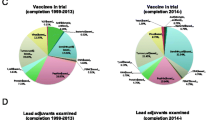Abstract
Introduction
In contemporary oncology drug development, implementation of novel early-phase designs with the ability to address multiple research objectives is needed to better refine regimens. This paper describes an adaptive design strategy for identifying a range of optimal regimens based on two endpoints within multiple cohorts. The proposed design was developed to address objectives in an early-phase trial of cancer vaccines in combination with agonistic antibodies to CD40 and CD27.
Materials and methods
We describe a model-based design strategy that was developed for a trial evaluating the safety and immunogenicity of vaccination with (1) peptides plus CD40 antibody and TLR3 ligand, (2) systemic administration of an agonistic CD27 antibody, and (3) to assess immune response from (1) and (2) compared to optimal controls in participants with stage IIB-IV melanoma.
Results and conclusions
The proposed design is a practical adaptive method for use with combined immunotherapy regimens with multiple objectives within multiple cohorts of interest. Further advances in the effectiveness of cancer immunotherapies will require new approaches that include redefining optimal strategies to take multiple regimens forward into later phases, incorporating additional endpoints in the dose selection process and testing drug combination therapies to improve efficacy and reduce toxicity. Our goal is to facilitate the acceptance and application of more novel designs in contemporary early development trials.

Similar content being viewed by others
Abbreviations
- DLT:
-
Dose-limiting toxicity
- FDA:
-
Food and drug administration
- IFA:
-
Incomplete Freund’s adjuvant
- Mel12.1:
-
12 Class I MHC-restricted melanoma peptides plus tetanus helper peptide
- MTD:
-
Maximum tolerated dose
- OBA:
-
Optimal biologic adjuvant
- OBD:
-
Optimal biologic dose
- UVA:
-
University of Virginia
References
Hobbs B, Barata P, Kanjanapan Y, Paller C, Perlmutter J, Pond GR, Prowell T, Rubin E, Seymour L, Wages NA, Yap T, Feltquate D, Garrett-Mayer E, Grossman W, Hong D, Ivy P, Siu L, Reeves S, Rosner G (2019) Seamless designs: current practice and considerations for early phase drug development in oncology. J Natl Cancer Inst 111:118–128
Paoletti X, Ezzalfani M, Le Tourneau C (2015) Statistical controversies in clinical research: requiem for the 3 + 3 design for phase I trials. Ann Oncol 26:1808–1812
Nie L, Rubin EH, Mehrotra N et al (2016) Rendering the 3 + 3 design to rest: more efficient approaches to oncology dose-finding trials in the era of targeted therapy. Clin Cancer Res 22:2623–2629
Wages NA, Chiuzan C, Panageas KS (2018) Design considerations for early-phase clinical trials of immune-oncology agents. J Immunother Cancer 6:81
Rosenberg SA, Yang JC, Restifo NP (2004) Cancer immunotherapy: moving beyond current vaccines. Nat Med 10:909–915
Finn OJ (2008) Cancer immunology. N Engl J Med 358:2704–2715
Gao J, Bernatchez C, Sharma P, Radvanyi LG, Hwu P (2012) Advances in the development of cancer immunotherapies. Trends Immunol 34:90–98
Sikora AG, Jaffarzad N, Hailemichael Y, Gelbard A, Stonier SW, Schluns KS et al (2009) IFN-alpha enhances peptide vaccine-induced CD8 + T cell numbers, effector function, and antitumor activity. J Immunol 182:7398–7407
Kantoff PW, Higano CS, Shore ND et al (2010) Sipuleucel-T immunotherapy for castration-resistant prostate cancer. N Engl J Med 363:411–422
Schwartzentruber DJ, Lawson DH, Richards JM, Conry RM, Miller DM, Treisman J, Gailani F, Riley L, Conlon K, Pockaj B, Kendra KL, White RL, Gonzalez R, Kuzel TM, Curti B, Leming PD, Whitman ED, Balkissoon J, Reintgen DS, Kaufman H, Marincola FM, Merino MJ, Rosenberg SA, Choyke P, Vena D, Hwu P (2011) gp100 peptide vaccine and interleukin-2 in patients with advanced melanoma. N Engl J Med 364:2119–2127
Hailemichael Y, Woods A, Fu T et al (2018) Cancer vaccine formulation dictates synergy with CTLA-4 and PD-L1 checkpoint blockade therapy. J Clin Invest 128:1338–1354
Patel PM, Ottensmeier CH, Mulatero C et al (2018) Targeting gp100 and TRP-2 with a DNA vaccine: Incorporating T cell epitopes with a human IgG1 antibody induces potent T cell responses that are associated with favourable clinical outcome in a phase I/II trial. Oncoimmunology 7:e1433516
Dillman RO, Cornforth AN, Nistor GI et al (2018) Randomized phase II trial of autologous dendritic cell vaccines versus autologous tumor cell vaccines in metastatic melanoma: 5-year follow up and additional analyses. J Immunother Cancer 6:19
Petroni GR (2006) Design issues for early-stage clinical trials. In: Disis M (ed) Immunotherapy of cancer. Human Press, Totowa, pp 479–485
Zohar S, Baldi I, Forni G, Merletti F, Masucci G, Gregori D (2011) Planning a Bayesian early-phase phase I/II study for human vaccines in HER2 carcinomas. Pharm Stat 10:218–226
Cunanan KM, Koopmeiners JS (2017) A Bayesian adaptive phase I-II trial design for optimizing the schedule of therapeutic cancer vaccines. Stat Med 36:43–53
Wang C, Rosner GL, Roden RBS (2018) A Bayesian design for phase I cancer therapeutic vaccine trials. Stat Med 38:1170–1189
Slingluff CL Jr, Petroni GR, Chianese-Bullock KA et al (2011) Randomized multicenter trial of the effects of melanoma-associated helper peptides and cyclophosphamide on the immunogenicity of a multipeptide melanoma vaccine. J Clin Oncol 29:2924–2932
Slingluff CL Jr, Lee S, Zhao F et al (2013) A randomized phase II trial of multiepitope vaccination with melanoma peptides for cytotoxic T cells and helper T cells for patients with metastatic melanoma (E1602). Clin Cancer Res 19:4228–4238
Slingluff CL Jr, Petroni GR, Chianese-Bullock KA et al (2007) Immunologic and clinical outcomes of a randomized phase II trial of two multipeptide vaccines for melanoma in the adjuvant setting. Clin Cancer Res 13:6386–6395
Zhu X, Nishimura F, Sasaki K et al (2007) Toll like receptor-3 ligand poly-ICLC promotes the efficacy of peripheral vaccinations with tumor antigen-derived peptide epitopes in murine CNS tumor models. J Transl Med 5:10
Bonhoure F, Gaucheron J (2006) Montanide ISA 51 VG as adjuvant for human vaccines. J Immunother 29:647–648
Wages NA, Conaway MR, O’Quigley J (2011) Continual reassessment method for partial ordering. Biometrics 67:1555–1563
O’Quigley J, Pepe M, Fisher L (1990) Continual reassessment method: a practical design for phase I clinical trials in cancer. Biometrics 46:33–48
Paoletti X, Kramar A (2009) A comparison of model choices for the continual reassessment method in phase I clinical trials. Stat Med 28:3012–3028
Lee SM, Cheung YK (2009) Model calibration in the continual reassessment method. Clin Trials 6:227–238
O’Quigley J (2006) Theoretical study of the continual reassessment method. J Stat Plan Infer 136:1765–1780
Horton BJ, Wages NA, Conaway MR (2019) Shift models for dose-finding in partially ordered groups. Clin Trials 16:32–40
Sabbatini P, Tsuji T, Ferran L et al (2012) Phase I trial of overlapping long peptides from a tumor self-antigen and poly-ICLC shows rapid induction of integrated immune response in ovarian cancer patients. Clin Cancer Res 18:6497–6508
Riviere MK, Le Tourneau C, Paoletti X et al (2015) Designs of drug-combination phase I trials in oncology: a systematic review of the literature. Ann Oncol 26:1036–1037
Iasonos A, O’Quigley J (2014) Adaptive dose-finding studies: a review of model-guided phase I clinical trials. J Clin Onc 32:2505–2511
FDA USDoHaHS, Administration FaD, Research CfBEa. Guidance for Industry Clinical Considerations for Therapeutic Cancer Vaccines (2011). https://www.fda.gov/regulatory-information/search-fda-guidance-documents/clinical-considerations-therapeutic-cancer-vaccines
Rahma OE, Gammoh E, Simon RM, Khleif SM (2014) Is the “3 + 3” dose escalation phase I clinical trial design suitable for therapeutic cancer vaccine development? a recommendation for alternative design. Clin Cancer Res 20:4758–4767
Iasonos A, Gönen M, Bosl GJ (2015) Scientific review of phase I protocols with novel dose-escalation designs: how much information is needed? J Clin Onc 33:2221–2225
Petroni GR, Wages NA, Paux G, Dubois F (2017) Implementation of adaptive methods in early-phase clinical trials. Stat Med 36:215–224
Wages NA, Slingluff CL Jr, Petroni GR (2017) Statistical controversies in clinical research: early-phase adaptive design for combination immunotherapies. Ann Oncol 35:696–701
Wages NA, Slingluff CL, Petroni GR (2015) A phase I/II adaptive design to determine the optimal treatment regimen from a set of combination immunotherapies. Contemp Clin Trials 41:172–179
Melssen MM, Petroni GR, Chianese-Bullock KA et al (2019) A multipeptide vaccine plus toll-like receptor agonists LPS or polyICLC in combination with incomplete Freund’s adjuvant in melanoma patients. J Immunother Cancer 7:163
Conaway MR, Petroni GR (2019) The impact of early phase trial design in the drug development process. Clin Cancer Res 19:819–827
Acknowledgements
The authors would like to thank the Editor and two reviewers for their comments that lead to an improved paper.
Funding
Dr. Wages is supported by Grant Number K25CA181638 from the National Cancer Institute. Dr. Petroni is partially supported by Grant Number R01CA142859 from the National Cancer Institute. Drs. Slingluff and Petroni are supported by a Team Science Award from the Melanoma Research Alliance. Supported in part by the Biostatistics Shared Resource, University of Virginia Cancer Center, University of Virginia (P30CA044579).
Author information
Authors and Affiliations
Contributions
All authors contributed to the study conception and design. The first draft of the manuscript was written by Nolan A. Wages and all authors commented on previous versions of the manuscript. All authors read and approved the final manuscript.
Corresponding author
Ethics declarations
Conflict of interest
Dr. Slingluff is an inventor on patents of peptides for use in clinical trials of cancer vaccines; these patents are held by the University of Virginia Licensing and Ventures Group. He also is on and the University receives funding for his roles as external advisory board member for Immatics, CureVac., and as PI for a clinical trial of a cell-based vaccine sponsored by Polynoma. He also receives support for investigator-sponsored cancer immunotherapy clinical trials from GlaxoSmithKline, Celldex, 3 M, and Merck. All remaining authors have declared no conflicts of interest.
Ethical approval
This article does not contain any studies with human participants performed by any of the authors.
Informed consent
This article does not contain any studies with human participants performed by any of the authors.
Additional information
Publisher's Note
Springer Nature remains neutral with regard to jurisdictional claims in published maps and institutional affiliations.
Electronic supplementary material
Below is the link to the electronic supplementary material.
Rights and permissions
About this article
Cite this article
Wages, N.A., Slingluff, C.L., Bullock, T.N. et al. Tailoring early-phase clinical trial design to address multiple research objectives. Cancer Immunol Immunother 69, 95–102 (2020). https://doi.org/10.1007/s00262-019-02442-5
Received:
Accepted:
Published:
Issue Date:
DOI: https://doi.org/10.1007/s00262-019-02442-5




